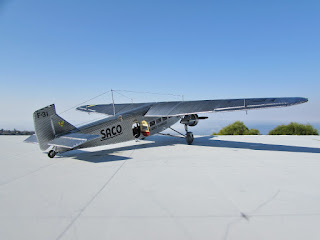There are planes that become classics, and there are kits that become classics as well.
In this case the classic kit is of a the classic plane, the venerable Ford trimotor, an American product that drew so much from Fokker and Junkers ideas, design, and construction techniques that some even considered it blatant plagiarism.
In any case, the trimotor soon became an ubiquitous sight in the American and foreign skies, and was popular with airliners and passengers alike.
Many were produced, and they operated wide and long, as the existing flying examples can attest.
As we all know there are two kits of it, Monogram's 1/77th scale of the 4AT, and Airfix's 1/72 scale of the 5AT.
The old Arfix kit depicts just one of the many diverse sub-types, and it is a good idea to check your chosen subject against actual photos of it, as you will be surprised to find that many details in the kit might not apply to your choice (or any choice), and the kit itself is peppered with inaccuracies that you may or may not like to live with. Some are easy to correct and/or not so relevant, while others are very difficult to correct and quite noticeable. Three of the latter are the really overly thick trailing edges, the absence of corrugations on the inner two thirds of the leading edges, and the "reversed" propeller blades. The mail holds in the wing are only suitable for some versions, as some did not have them at all, and others had a single-bay hold, not a double bay as in the kit. The frames for them in the kit are inaccurate, as the big hold was divided in two to clear a spar in reality. So you either fix that -photos in hand-, or just close them shut.
If you want to know more, you may visit the building thread:
https://wingsofintent.blogspot.com/2020/08/ford-trimotor-modified-airfix-172-kit.html
If you are lenient or do not overly fuss about accuracy, you may consider that the kit still holds its own, but more demanding modelers may be eager for a more modern and accurate kit. I think they may as well pull up a chair, as this is not very likely to happen.
I believe it still renders a fair replica when in good hands, it's affordable and abundant, and there are aftermarket masks and decals available for it. Why this kit became a classic, with the completely horrid fit issues and inaccuracies it has, it's yet another of the modeling universe mysteries.
The Arfix kit can be built by a reasonably experienced modeler, with lots of work to fix issues: the locating points for the engine gondolas that guarantee bad fit, as well as the cabin and fuselage floor, that do the same, and the fit of the cabin inside the fuselage. All these issues combined explain the recurrent news of modelers going crazy and pretending, for example, that they are Martians. The cure is not easy, and the problem is compounded by confusing and poor instructions for the sub-assemblies involved.
The model is as problematic as Henry Ford, an execrable and confessed racist -pals with another racist, Charles Lindbergh, a perfect example of historical whitewashing, even up to these days.
The model:
In this case, the chosen subject is the SACO (Servicio Aéreo Colombiano -Colombian Air Service) airplane F-31, in which Carlos Gardel, the Argentinean world-renowned tango singer tragically lost his life -together with his entourage and part of the crew- in a catastrophic accident during take-off while on tour in Colombia.
There are so many attractive trimotor schemes, older and newer, that actually makes it difficult to chose one of them to replicate. There are even British-registered trimotors! I have already folders for potential candidates, in case I wanted to go through the ordeal again (which I very much doubt).
For those interested in lists, here is what has been modified on this model:
- Addition of a full restroom
- Fabrication and addition of the missing sections of the corrugated leading
edge -an omission that lets the kit down, a kit that otherwise may deserve better marks
- Replacement of landing lights and addition of navigation lights
- Modification of the propellers to correct reversed parts on kit
- Substitution of the center (exposed in this case) engine for an aftermarket part
- Detailing of engine gondolas with shrouds, louvers and other details
- Replacement of most of the original center engine exhaust
- Addition of antenna masts and cables
- Addition of cabin door step
- Addition of passing red light on the leading edge
- Thinning of wing trailing edges
- Removal of molded-in control arms and substitution for new parts
- Addition of all control cables on fuselage, tail and wing
- Addition of control cable guides along fuselage
- Replacement of tailwheel and all associated parts, adding missing details like bungee cords
- Re-location of the misguiding holes for the engine struts
- Replacement of aileron control horns
- Addition of tail rigging
- Fabrication of realistic wing mail hold and associated details
- Correction of kit's mail holds to fit the version
- Opening of all cabin and cockpit doors
- Addition of restroom discharge on fuselage bottom
- Deletion of details not pertinent to this specific version
- New decal sheet made by Arctic decals specific for the plane modeled
- Addition of instruments on the engine struts
My thanks to Ricardo Fiorio, a friend for many decades, who provided key information to replicate Gardel's plane.
My gratitude to Arctic decals, who kindly allows me to commission sets so I can continue to present these off-the-beaten-path types.
If you want a trimotor, this kit may deserve the effort and time you invest on it to cure its many issues in order to obtain a replica of this iconic corrugated metal classic.
It's up to you.

































That's really impressive!
ReplyDeleteThanks!
Delete